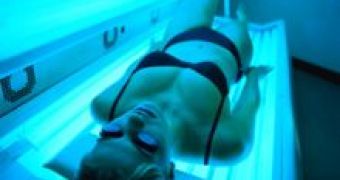The use of tanning beds not only provides a darker skin but also boosts the level of endorphins, the organism's natural drugs. Moreover, when frequent users of tanning beds stop using them they experience withdrawal symptoms similar to the withdrawal symptoms of drug addicts. This is what Mandeep Kaur and colleagues from Wake Forest University Baptist Medical Center have found by comparing the reactions of frequent tanners, who use tanning beds 8 to 15 times a month, to those of infrequent tanners, who use tanning beds no more than 12 times a year.
The first clue that some people might use the tanning beds not only just for getting a darker skin comes from the fact that they are using the beds more often than necessary to maintain a tan. Wake Forest researchers have tested the hypothesis that exposure to ultraviolet light may produce endorphins, brain chemicals that are linked to pain relief and euphoric feelings.
They designed two identical looking beds, one of which was using UV light, while the other used only visible light. The participants spent half of each tanning session in one bed and half in the other. The results revealed greater relaxation and lower tension after UV exposure compared to non-UV exposure. Although this has shown that UV can relax you, it didn't provide a definite proof that endorphins are the intermediaries that actually cause the relaxation.
In order to determine whether the relaxation was indeed provoked by endorphins, researchers looked for withdrawal effects of the tanning sessions. Half of tanners have now received a substance called naltrexone, which blocks endorphins (as well as other opium-like drugs such as morphine). Participants then tanned again in both the UV and non-UV beds.
Half of the frequent tanners have reported nausea or anxiety, while none of the infrequent tanners felt any negative effect.
"The finding was unexpected and is consistent with the hypothesis that frequent tanning is may be driven in part by a mild dependence on opioids, most likely endorphins," said Steven Feldman, a professor of dermatology. "The nausea and jitteriness induced by the medication are consistent with symptoms of mild opiate withdrawal."
Kaur said the finding is significant because exposure to UV through tanning has been shown to damage the genetic information in cells and is linked to the development of skin cancer. However, in spite of the risk, the popularity of tanning beds has been constantly increasing during the last decades and the endorphin addiction might offer some understanding of why frequent tanners choose the activity.
Another activity that is known to be driven by endorphins in a very similar way is jogging, which is associated with the so-called "runner's high".

 14 DAY TRIAL //
14 DAY TRIAL //